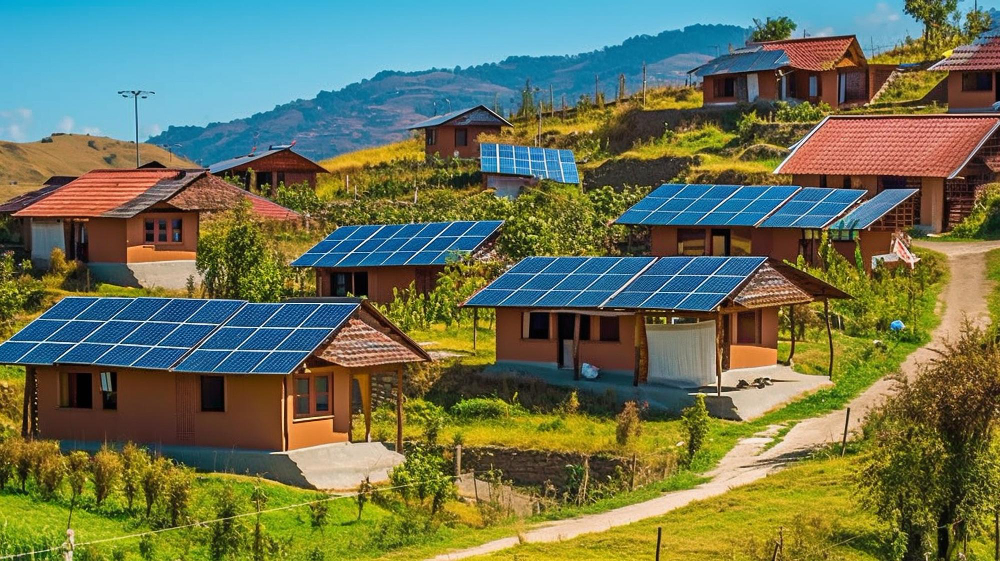As cities grow and develop, a phenomenon known as the Urban Heat Islands (UHI) effect has become a pressing concern. This effect occurs when urban areas become significantly warmer than their rural surroundings due to human activities, including increased construction, energy consumption, and the use of materials like asphalt and concrete that retain heat. With rising global temperatures, the UHI effect intensifies, leading to higher energy costs, poor air quality, and discomfort for city dwellers. Fortunately, solar energy presents a promising solution. By integrating solar technology into urban areas, we can actively reduce the Urban Heat Island effect and create healthier, more sustainable cities.
Understanding the Urban Heat Island Effect
Urban Heat Islands occur when the natural landscape is replaced with dense buildings, roads, and other infrastructure that absorb and retain heat. These surfaces trap heat during the day and slowly release it at night, causing cities to remain warmer than rural areas even after sunset. In some cities, this temperature difference can be as much as 10°C (18°F). Factors contributing to UHIs include limited vegetation, waste heat from buildings and vehicles, and high energy consumption in urban areas.
The Role of Solar Energy in Reducing Urban Heat Islands
Solar energy has the potential to play a significant role in combating the UHI effect. Solar power systems can be integrated into urban infrastructure to provide clean, renewable energy while also helping to cool cities. Here are some of the ways solar energy can contribute to UHI reduction:
1. Urban Solar Initiatives
Many cities around the world are launching urban solar initiatives to promote the use of solar panels on rooftops and public spaces. These initiatives encourage businesses, residents, and governments to install solar panels on their properties, reducing reliance on traditional energy sources and lowering the overall demand for electricity during hot summer months.
Installing solar panels on rooftops not only generates clean energy but also provides an added layer of insulation. The panels absorb sunlight, preventing the roof from becoming excessively hot. This reduces the amount of heat that enters buildings, making them cooler and decreasing the need for air conditioning. As a result, cities that embrace urban solar initiatives can reduce the UHI effect while also promoting renewable energy use.
2. Green Roofs and Solar Shading Solutions
One of the most innovative approaches to reducing the UHI effect involves combining solar energy systems with green roofs. Green roofs, which are roofs covered with vegetation, help cool urban areas by absorbing sunlight, providing shade, and reducing heat retention. When combined with solar panels, green roofs create a dual benefit: they generate energy while also cooling the building and surrounding area.
Solar shading solutions, such as solar canopies or pergolas, also offer effective heat reduction strategies. By installing solar panels as shading structures in parking lots, public parks, and building exteriors, we can create cooler spaces beneath them. These solar canopies not only generate electricity but also provide shade, making public areas more comfortable during hot weather.
3. Community Solar Projects
Community solar projects offer a way for urban residents to collectively invest in and benefit from solar energy without installing individual systems on their properties. These projects allow multiple households or businesses to share the electricity generated from a central solar array, often located in underutilized urban spaces like vacant lots or rooftops of public buildings.
Community solar projects help reduce the UHI effect by generating renewable energy on a larger scale, which reduces the need for fossil fuels to power the city. Additionally, many of these projects are designed with sustainability in mind, incorporating greenery and other heat-reducing features around the solar arrays to further cool the surrounding area.
4. Heat Reduction Strategies in Urban Planning
Cities that incorporate solar energy into their broader urban planning efforts are better equipped to address the challenges posed by the UHI effect. By designing new buildings and neighborhoods with solar power in mind, urban planners can create cooler, more energy-efficient environments.
For example, solar panels can be integrated into the design of buildings, not only as rooftop systems but also as part of the building facade. These panels act as shading devices, reducing the amount of sunlight that enters the building and thus keeping it cooler. Urban planning can also prioritize the use of solar energy for public infrastructure, such as streetlights, bus stops, and benches, which can all be powered by solar panels.
Benefits of Using Solar Energy to Combat Urban Heat Islands
There are several key benefits to using solar energy as a tool to reduce the UHI effect:
-
Energy Efficiency:
Solar panels reduce energy consumption by providing a clean, renewable energy source, thereby lowering the demand for traditional electricity, especially during peak summer months when the UHI effect is strongest.
-
Cooling Effect:
Solar installations can directly reduce heat in urban areas by providing shade and reducing the heat absorbed by buildings and infrastructure. This helps lower the overall temperature of cities.
-
Improved Air Quality:
By reducing the demand for fossil fuels, solar energy helps lower carbon emissions and air pollutants, improving air quality in cities and reducing health risks for residents.
-
Cost Savings:
As solar technology becomes more affordable, businesses and residents can save on energy costs by generating their electricity. Additionally, reduced energy consumption leads to lower utility bills, particularly during hot weather when cooling demands are high.
-
Increased Resilience:
Solar energy systems help make cities more resilient to extreme weather events, such as heat waves, by providing a stable and reliable source of electricity that isn’t dependent on the grid.
Conclusion
The Urban Heat Island effect is a growing challenge for cities worldwide, but solar energy offers a viable and sustainable solution. By incorporating solar power into urban planning, encouraging community solar projects, and utilizing innovative solar shading and green roof solutions, we can cool our cities, reduce energy consumption, and promote environmental sustainability. As urban areas continue to expand, embracing solar energy will be crucial in creating healthier, more livable environments for city dwellers while mitigating the impacts of climate change.





